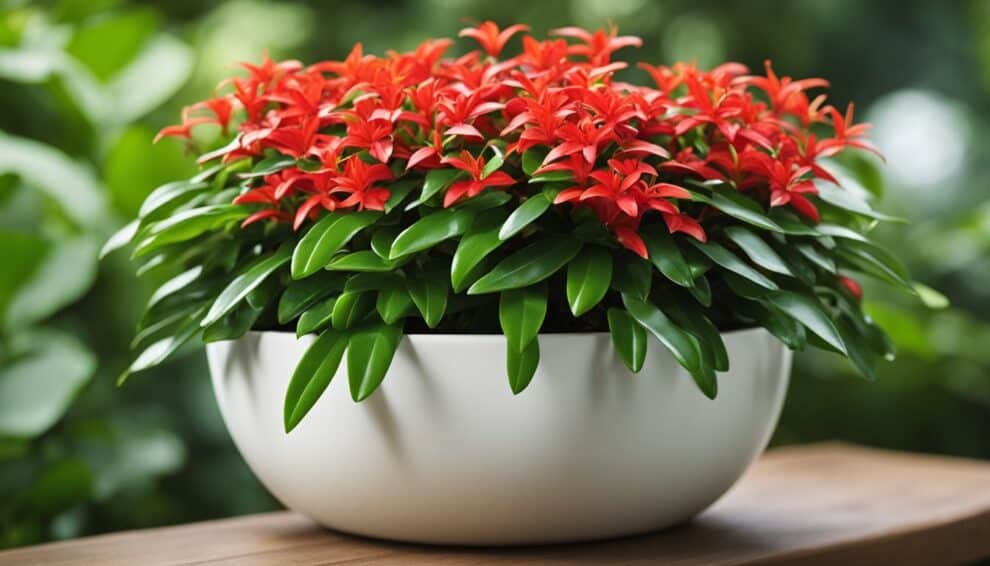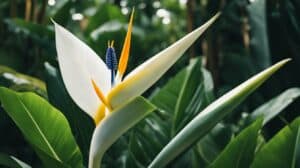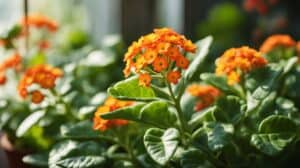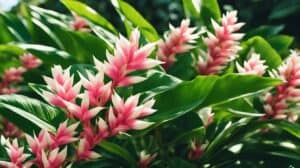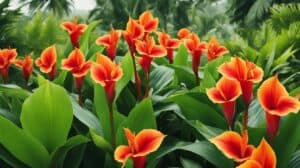Aeschynanthus radicans, commonly known as the Lipstick Plant, is a popular houseplant that is native to Southeast Asia.
This plant is loved for its striking appearance, with its bright red flowers that resemble tubes of lipstick.
However, caring for this plant can be a bit tricky, especially for beginners.
In this article, we will provide a simplified guide to Lipstick Plant care, so you can enjoy a flourishing Aeschynanthus radicans in your home.

One of the main challenges in caring for the Lipstick Plant is providing the right amount of light.
This plant thrives in bright, indirect light, but direct sunlight can scorch its leaves. Another important factor is watering.
Overwatering can lead to root rot, while underwatering can cause the plant to wilt and drop leaves.
In this guide, we will provide tips on how to strike the right balance when it comes to light and water, as well as other important aspects of Lipstick Plant care.
Getting to Know Your Lipstick Plant
Origins and Characteristics
The Lipstick Plant, also known as Aeschynanthus Radicans, is a tropical plant native to Southeast Asia.
It is a member of the Gesneriaceae family, which includes other popular houseplants like African Violets and Gloxinias.
The Lipstick Plant is named for its bright red, tubular flowers that resemble a tube of lipstick.
This plant has a trailing habit, making it an excellent choice for hanging baskets or as a trailing plant on a shelf.
Its leaves are glossy and green, with a slightly puckered texture. The Lipstick Plant can grow up to 12 inches tall and 24 inches wide.
Varieties of Aeschynanthus Radicans
There are several varieties of Aeschynanthus Radicans, each with its unique characteristics. Here are a few popular ones:
-
Aeschynanthus Radicans ‘Mona Lisa’: This variety has variegated leaves with yellow and green stripes.
It produces bright red flowers that bloom in clusters.
-
Aeschynanthus Radicans ‘Black Pagoda’: This variety has dark green leaves with a slightly purple tint.
It produces deep red flowers that bloom in clusters.
-
Aeschynanthus Radicans ‘Rasta’: This variety has green leaves with white veins and produces bright red flowers with yellow tips.
When selecting a Lipstick Plant, consider the variety that best suits your preferences and the growing conditions in your home.
With proper care, your Lipstick Plant will thrive and bring a vibrant pop of color to your space.
Essential Care Instructions

Light Requirements
The lipstick plant requires bright, indirect light to thrive. Direct sunlight can scorch the leaves, while too little light can cause stunted growth.
Place the plant near a window that receives filtered light or in a well-lit room away from direct sunlight.
Watering Techniques
The Aeschynanthus Radicans prefers consistently moist soil, but overwatering can lead to root rot.
Water the plant when the top inch of soil feels dry to the touch. Use room-temperature water and allow excess water to drain from the pot.
Avoid getting water on the leaves, as this can cause spotting.
Temperature and Humidity Needs
The lipstick plant prefers temperatures between 60-75°F (15-24°C) and high humidity levels.
Mist the leaves regularly or place a humidifier near the plant to maintain humidity levels. Avoid placing the plant near cold drafts or hot, dry air.
Soil and Fertilization
The Aeschynanthus Radicans prefers well-draining soil that is rich in organic matter. Use a potting mix that contains peat moss, perlite, and vermiculite.
Fertilize the plant every 2-3 weeks during the growing season with a balanced fertilizer. Reduce fertilization during the winter months.
Pruning and Maintenance
Regular pruning can help maintain the shape and health of the lipstick plant. Prune back leggy stems and remove any dead or yellowing leaves.
Pinch back the tips of the plant to encourage branching. Repot the plant every 1-2 years or when it outgrows its container.
Troubleshooting Common Issues

Aeschynanthus Radicans, or lipstick plant, is a relatively easy plant to care for. However, like all plants, it can encounter some problems.
Here are some common issues and how to solve them.
Pest Infestations
One of the most common issues with the lipstick plant is pest infestations. Mealybugs, spider mites, and scale insects can all be problematic.
These pests can cause yellowing leaves, stunted growth, and even plant death if left untreated.
To prevent pest infestations, it is important to keep the plant clean and free from dust and debris.
Regularly inspect the plant for signs of infestation, such as webbing or white, cotton-like spots on the leaves.
If you do notice an infestation, isolate the plant and treat it with an insecticidal soap or neem oil.
Disease Prevention
Lipstick plants are generally resistant to disease, but they can still be susceptible to fungal infections.
These infections can cause leaf spotting, yellowing, and wilting.
To prevent fungal infections, make sure the plant is not overwatered and that there is good air circulation around the plant.
If you do notice signs of a fungal infection, remove the affected leaves and treat the plant with a fungicide.
Leaf Discoloration and Drop
If your lipstick plant’s leaves are turning yellow or dropping off, it may be a sign of overwatering or underwatering.
Inconsistent watering can also cause the plant to wilt or become stunted.
To prevent leaf discoloration and drop, make sure the plant is watered consistently and that the soil is allowed to dry out slightly between waterings.
Avoid placing the plant in direct sunlight or near drafts, as this can also cause leaf drop.
By following these tips, you can keep your lipstick plant healthy and flourishing.
Propagation and Repotting

Propagation Methods
Lipstick plants can be easily propagated through stem cuttings.
The best time to take cuttings is during spring or early summer when the plant is actively growing. Here are the steps to propagate your lipstick plant:
- Select a healthy stem that is at least 4-6 inches long and has a few leaves.
- Cut the stem just below a node, which is where the leaves attach to the stem.
- Remove the lower leaves from the stem, leaving only a few leaves at the top.
- Dip the cut end of the stem in rooting hormone powder.
- Plant the stem in a pot filled with a well-draining potting mix.
- Water the soil and cover the pot with a plastic bag or a clear plastic container to create a mini greenhouse.
- Place the pot in a bright, indirect light and keep the soil moist.
- After a few weeks, the stem should start to develop roots.
Once the roots are well-established, you can remove the plastic cover and treat the new plant as you would a mature lipstick plant.
Repotting Steps
Lipstick plants prefer to be slightly root-bound, so you don’t need to repot them often.
However, if you notice that the roots are growing out of the drainage holes or the plant is struggling to grow, it may be time to repot.
Here are the steps to repot your lipstick plant:
- Choose a pot that is one size larger than the current pot and has drainage holes.
- Fill the new pot with a well-draining potting mix.
- Gently remove the plant from its current pot, being careful not to damage the roots.
- Loosen any tangled roots and trim any dead or damaged roots.
- Place the plant in the new pot and fill in the gaps with fresh potting mix.
- Water the plant thoroughly and allow the excess water to drain out of the bottom.
- Place the plant in a bright, indirect light and avoid direct sunlight for a few days to allow the plant to adjust to its new pot.
By following these simple propagation and repotting steps, you can ensure that your lipstick plant thrives and continues to brighten up your home with its beautiful blooms.
Frequently Asked Questions

How often should I water my Aeschynanthus radicans?
Lipstick Plants prefer to be kept evenly moist, but not waterlogged. It is recommended to water your plant when the top inch of soil feels dry to the touch.
During the growing season, which is typically from spring to fall, you may need to water your plant more frequently.
In the winter, you can reduce watering to allow the soil to dry out a bit more between waterings.
What are the ideal lighting conditions for a thriving Lipstick Plant?
Lipstick Plants prefer bright, indirect light.
They can tolerate some direct sunlight in the morning or late afternoon, but too much direct sunlight can scorch their leaves.
If your plant is not getting enough light, you may notice that its leaves are turning yellow or dropping off.
What is the recommended humidity level for Lipstick Plants?
Lipstick Plants prefer a humid environment, with a humidity level of around 50-60%.
You can increase humidity around your plant by placing a humidifier nearby, grouping it with other plants, or placing a tray of water near it.
Misting your plant can also help increase humidity, but be careful not to mist too often as this can lead to fungal growth.
How do I propagate a Lipstick Plant successfully?
Lipstick Plants can be propagated from stem cuttings.
Take a cutting that is 4-6 inches long, remove the lower leaves, and dip the cut end in rooting hormone.
Plant the cutting in a pot with well-draining soil and keep it moist. Place the pot in a bright, indirect light and wait for roots to develop.
Can you provide tips for pruning and maintaining the shape of a Lipstick Plant?
Lipstick Plants can be pruned to maintain their shape and encourage bushier growth. Prune back any leggy or overgrown stems to a leaf node.
You can also pinch back the tips of stems to promote branching. Regular pruning will keep your plant looking full and healthy.
What are the common pests to look out for when caring for a Lipstick Plant?
Lipstick Plants are susceptible to mealybugs, spider mites, and scale.
Check your plant regularly for any signs of pests, such as webbing, sticky residue, or tiny insects.
If you do notice pests, isolate your plant and treat it with an appropriate insecticide or insecticidal soap.






